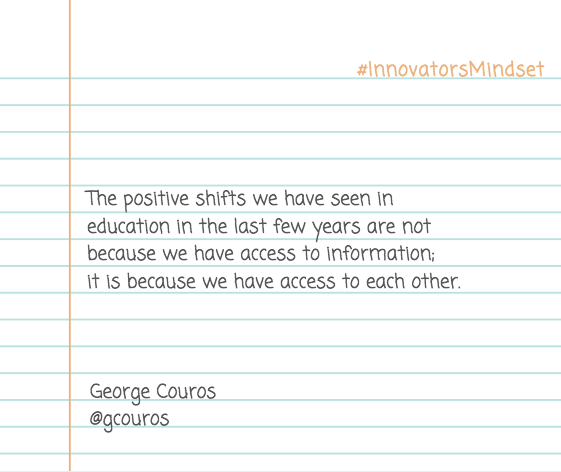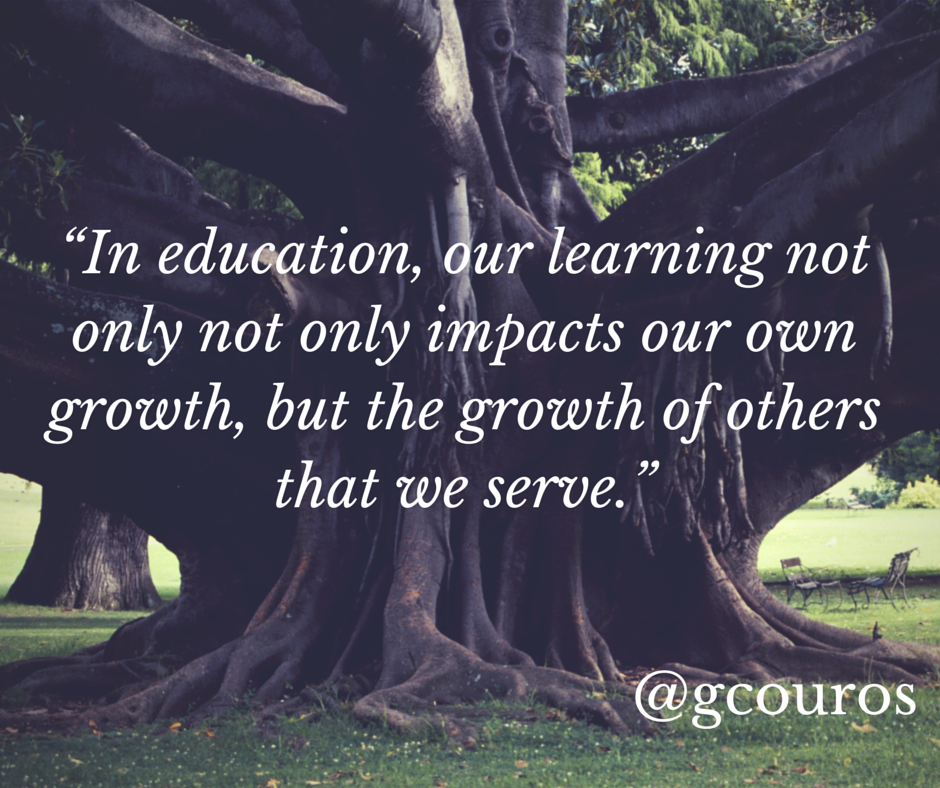This is a compilation of some highlights in our third week of Innovator’s Mindset MOOC Season 2. To join the conversation, check out IMMOOC.Org, #IMMOOC on Twitter, or join us on Facebook.
George makes a strong statement in Chapter 4. “If we want meaningful change, we have to make a connection to the heart before we can make a connection to the mind.” The live episode for week 3 revolves around the theme of relationships and how to best utilize them to inspire innovation.
[youtube https://www.youtube.com/watch?v=3dwf6aGvY2s&w=560&h=315]
Stuck in a Rut v In a Groove
Congenial v Collegial
Classroom Teacher v School Teacher
How do we use our relationships to help create a culture of innovation?
George challenges us to think about how we use our relationships. Getting the most out of those relationships requires invested time. George brings in the analogy of the Chick-fil-a commercial, “Stuck in a Rut”, where an observer sees someone being stuck-in-a-rut versus them actually feeling like they are in a groove. In Chapter 5 we find George saying, “Innovation often comes from conflict and disagreement, not in an adversarial way but in a way that promotes divergent thinking.”
Katie adds that relationships do not mean we have to agree with everything or assume we know everything. We need to be vulnerable and allow people to “hold up the mirror” for us and challenge us to grow. George says he is known for challenging those he knows by telling them to “get over it, do it and move on”. Amber added that these relationships give us the accountability as she keeps moving forward. Matt states the importance of relationships being the foundation needed in order to “call a spade a spade” without it hurting feelings. He adds that taking relationships to a different level from congeniality to collegiality is what allows us to grow. This idea stems from an article he recommends by Rob Evans, Ed.D. “Getting to No: Building True Collegiality in Schools
Engagement v Empowerment
Could engagement breed empowerment?
George tells us that empowerment of learning is our goal. Katie stresses that there are different levels of engagement. How students are using their knowledge is the question we need to ask ourselves. Matt’s building is motivated under the motto, “Own It”. They encouraged students to take ownership of their learning and figuring it out. He believes that this can happen with the right topic and level of connection. He saw success when students and teachers were collaborating beyond their walls about what was learned. Amber believes technology can be a tool that allows kids to be engaged and empowered and take learning to a deeper level. However, we need to be aware that engagement can merely be compliance which does not equal empowerment.
In Chapter 4, George inspires us when he states, “Our job, sometimes, is simply to be the spark, help build confidence, and then get out of the way. If innovation in any school or school division is solely dependent on one person, it will continue to happen in pockets.”
This week covered Chapters 4 through 7. George challenged us to write multiple short blogs and keep them under 200 words including visuals, video, or whatever works.

How do you create or build on these conditions to support innovation? What has been the impact on those you serve?
In Chapter 5 George encourages us, “Being present, learning first, and leading with the learner in mind will help you grow as an innovative leader.”
Lauren Mertz began a voluntary book club for teachers:
Each month a new title is chosen, and teachers can jump in and out of the book club whenever they choose. These experiences have given teachers opportunities to share their thoughts.
George Couros participates himself this week and offers an idea for a staff day:
Have groups discuss the same question (what are some ideas or practices we need to rethink in education?), and then think of a consensus three to bring to a larger group. Then pose “ways forward”, and what is possible now to make these realities.
Two things here…
This creates time for “problem finding” and “problem solving”, not one or the other.
The other point is that it shows people that we can create the change we want, and that we do not have to wait for someone else to do it for us.
What are your connections to the “School vs Learning Image? What would you add or modify?
In Chapter 6 George states, “School promotes starting by looking at answers. Learning promotes starting with questions. School is about consuming. Learning is about creating.”
John Bennet writes about his belief of learning and hints about his OSCAR problem solving procedure:
My belief: Learning (and any situation faced) will yield a better result more quickly IF approached as a ‘problem to be solved.’ That procedure used will be random and non-linear to achieve the optimum learning.
Katie Martin uses a line from Alanis Marissette in her blog this week looking at school verus learning – “Isn’t it ironic, don’t you think?”
The other day my daughter asked me, “Why can our teachers chew gum and we can’t?” I didn’t have an answer because, to be honest, I have no idea. It got me thinking about so many rules and procedures that we have put in place for kids (and adults) that are more conducive to the game of school than actual learning and can hinder us from developing the empowered learners that our world needs.
Which “what if” question challenges your thinking in the Innovator’s Mindset? What would you add to the list of what ifs? Discuss your “vision” for education.
George uses the process of using “What if?” questions to help create visions and developing a strategy to get there which is discussed further in Chapter 7. One of those questions is, “What if we empowered students to make a difference in the world today and in the future?”
Amber McMatch tells a story about how to best approach “What Ifs? in a scene between a teacher and the principal and ends with this statement:
Your teachers are smart human beings. When they come to you with innovation, they deserve to be talked to with ALL CAPS honesty, not dismissed with manufactured rhetoric.
Cori Orlando takes each “What if?” question and ends them with “Why not?”
Why do those statements have to be something we can only wonder about. As innovators…as educators, we should look at that list and ask ourselves: “Is this currently happening? If the answer is “no”, then WHY NOT?
Laurie Williams‘s vision is found in her blog “‘Purpose’ Innovation” and implementing it with “vintage” innovation.
The Innovator’s Mindset suggests a vision statement be “direct enough to memorize,” so here goes:
(Insert school here) is home to learners of all ages nurtured in a culture of curiosity, collaboration, and reflection and impassioned by the goals of sustainability and world peace.
Michael Buist says, “What if I made it the best day ever?”
Share some of your best ideas for building relationships and a culture of trust in your position.
Annick Rauch says building relationships can be simple:
Supervising outside for me usually means getting a little out of breath, maybe even a little sweaty, and playing tag with my students, past, present and future. It’s seriously a blast for everyone and such a fun and easy way to create and grow those relationships.
Kristen Roe fosters team building with staff and students:
Just this past Friday at a staff development day we started off the day with the Human Knot. Just simple activities that call on them to work together can help build team unity.
Some Inspiring Quotes posted by #IMMOOC Participants
In closing I leave you with this statement by George in Chapter 4: “As leaders in education our job is not to control those whom we serve but to unleash their talent. ” Aaron Hogan extends on this idea of unleashing talent with this inspiring blog, “Risks Worth Taking”. “Who do you need to invite on stage?”
We are better together and in the end students are the winner,
Valerie













